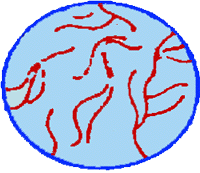|
PinkMonkey Online Study Guide-Biology
14.1 KINGDOM : MONERA
These are the oldest, simplest and most numerous microorganisms.
They are distinguished by the following characters:
I. They are prokaryotes.
II. They are mostly unicellular, but may be in the form of colonies or filaments of independent cells.
III. Their mode of nutrition is mainly absorptive, but some are photosynthetic or chemosynthetic.
IV. They are usually nonmotile, but some may have
flagella and gliding movements. Cilia are absent.
V. Their reproduction is primarily asexual, by fission.
Monera includes heterogenous microorganisms including
archaebacteria, eubacteria, actinomycetes and cyanobacteria.

(a) Archaebacteria : (Archaeos : old)

Figure 14.7 Archaebacteria
These are ancient bacteria which probably evolved
3 billion years ago. And are now known as "living fossils".
They are biologically different from the present day bacteria
in two respects, i.e. cell wall does not contain muramic acid,
but it is composed of proteins and polysaccharides and the cell
membrane consists of branched chain lipids. This enables them
to tolerate the extremes of heat and pH. They are divided into
two sub-groups:
(i) Methanogens : These are strictly anaerobic bacteria which produce methane (CH4) from CO2 and formic acid, hence the name. They are present in salty, marshy places, in the stomach of cattle and in organic matter or sewage. Methane gas produced in biogas plants is due to these bacteria. They are also called halophiles as they have an affinity for salt. They can cause spoilage of salted fish.
Examples: Halobacterium, Halococcus.
|
Table of Contents
14.0
Introduction
14.1 Kingdom
: Monera
14.2 Kingdom : Protista
14.3 Kingdom : Plantae
14.4 Kingdom : Fungi
Chapter
15
|